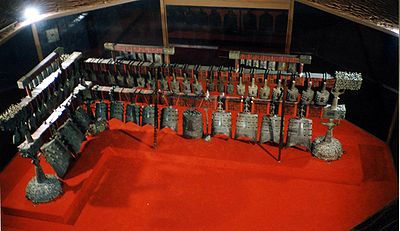- Tomb of Marquis Yi of Zeng
-
 Top view of the Bianzhong of Marquis Yi of Zeng
Top view of the Bianzhong of Marquis Yi of Zeng
The Tomb of Marquis Yi of Zeng (Chinese: 曾侯乙; pinyin: Zēng Hóu Yǐ) is an important archaeological site in Suizhou, Hubei, China, dated sometime after 433 BCE. The tomb contained the remains of Marquis Yi of Zeng. Zeng was a minor state subordinate to its powerful neighbor, Chǔ, during the Warring States Period.
The People's Liberation Army accidentally discovered the tomb in 1977 while destroying a hill to build a factory at Leigudun. The tomb was constructed of large wooden timbers and covers an area of 220 square meters. The tomb is divided into four separate chambers. The northern chamber is the smallest and contained military artifacts. The eastern chamber contained the tomb of Marquis Yi, who was buried in a wooden lacquer coffin nested inside a larger lacquer coffin. This chamber also contained eight other coffins that held the remains of eight women. The western chamber contained thirteen coffins that held the remains of thirteen other women. The central chamber is the largest, and contained a large ensemble of ritual musical instruments, including a set of 64 bianzhong (bronze bells).
In 1981, a less well-preserved and smaller tomb was discovered about 100 meters away, containing the remains of a woman related to Marquis Yi. This tomb contained a less extravagant set of 36 bronze bells and other musical instruments.
The most famous discovery at the tomb is the large set of bianzhong, which required a cast of five members to be played, and were struck with wooden mallets to produce music. The bells are two-toned, producing two distinct tones when struck at the center or the side; this property is enabled because the bells have an almond-shaped cross-section. The bells cover a range of five octaves. The collection also contains a non-matching bell, a memorial to Marquis Yi from King Hui of Chu, recording King Hui's rushed trip from the west to create the bell and attend the Marquis's funeral during the 56th year of King Hui's reign; the inscription on the bell dates the event to 433 BCE. The bells were inscribed with music notations that detailed the relationship among the pitch standards of Zeng, Chu and Zhou.
Other musical instruments in the ensemble include stone chimes. Various string instruments were also discovered in the tombs, including se, qin and zhu.
The tomb also contained pan flutes (paixiao), flutes and special sheng, each made from a one-piece body through a time-consuming procedure; a gourd would be placed inside a mold that held the desired shape of the instrument. Once the gourd matured, it would take the shape of the mold that conformed to the desired musical properties of the instrument.
In addition to aesthetic artifacts, the tomb contained a trove of weaponry, including arrowheads, dagger-axes spear tips and chariot wheel spokes.
This tomb is important in the history of Ancient Chinese glass, as it contains 173 eye beads that were made in a western Asian style, similar to some found in Gilan, Iran.
The date of the Marquis's death or an important date in his life has been extrapolated to the evening of May 3, 433 BCE using calendar data from a lacquered clothing chest. The date is written as "甲寅三日".
The earliest examples of Chinese ink writings on bamboo (Zhujian) were discovered in this tomb, showing the calligraphic styles of the Chu or Zeng state. They recorded the people who attended the Marquis's funeral, such as the officials and royalty of the Chu and Zeng states and also included details of their transportation, such as number of horses carrying the chariots. These bamboo slips provide important information on the development of Chinese brush calligraphy.
See also
- List of Chinese cultural relics forbidden to be exhibited abroad
References
- So, Jenny F., (2000), Music in the Age of Confucius, Washington, Smithsonian, ISBN 0-295-97953-4
- Kwan, Simon, Early Chinese Glass.
- von Falkenhausen, Lothar. (1993). Suspended Music: Chime Bells in the Culture of Bronze Age China. Berkeley, University of California Press.
External links
Chinese bronzes Selected
vessel types
Other Taotie (饕餮) • Bianzhong (編鐘) • Tomb of Marquis Yi of Zeng (曾侯乙) • Xiqing Gujian (西清古鑑) • Chinese bronze inscriptionsCategories:- Archaeological sites in China
- Chu (vassal state)
- Zhou Dynasty
Wikimedia Foundation. 2010.
